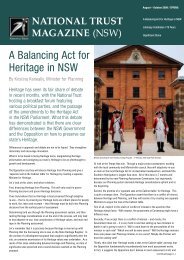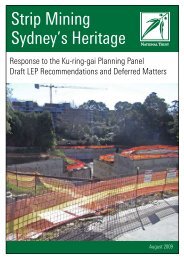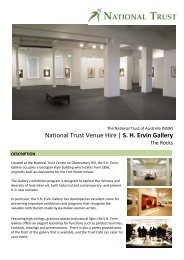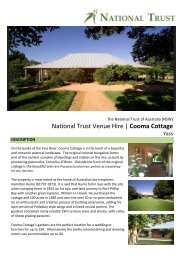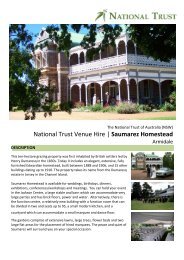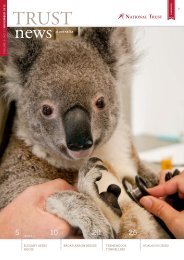Guidelines for Cemetery Conservation - National Trust of Australia
Guidelines for Cemetery Conservation - National Trust of Australia
Guidelines for Cemetery Conservation - National Trust of Australia
Create successful ePaper yourself
Turn your PDF publications into a flip-book with our unique Google optimized e-Paper software.
GUIDELINES FOR CEMETERY CONSERVATION<br />
PART THREE - HOW<br />
In many cases, funds and ef<strong>for</strong>t are wasted and even counterproductive,<br />
spent on inappropriately strict “beautification”<br />
Some visitors may object to the resulting aesthetics, but the <strong>National</strong> <strong>Trust</strong> believes that it is<br />
acceptable <strong>for</strong> an old cemetery to show that it is old and not in active use, providing that<br />
important values are protected. It is open to individuals to arrange a greater level <strong>of</strong><br />
maintenance on plots where they have an interest.<br />
2.3.2 Grave plantings<br />
In older cemeteries plants have sometimes spread from individual graves and become<br />
naturalised. They do not damage the cemetery and in many cases contribute substantially to<br />
the aesthetic and nostalgic qualities and to the cultural significance. These qualities should<br />
not be destroyed by excessive mowing, trimming or poisoning.<br />
Bulbs and self-sown annuals may be only apparent at certain seasons, so any work must be<br />
guided by observations made and recorded over a full year, involving both native plants and<br />
introduced species – many <strong>of</strong> which may now be unfashionable. This aspect needs great care<br />
and a good deal <strong>of</strong> expertise. Pretty or rare small flowers may need the shade and protection<br />
<strong>of</strong> a “weed” with which they share a grave plot. The presence <strong>of</strong> such rarities (and hence the<br />
value <strong>of</strong> the “weeds”) may only be apparent to a practised eye, and then only at certain times.<br />
In the case <strong>of</strong> the slightest doubt, expert advice is needed be<strong>for</strong>e any action.<br />
2.3.3 Native vegetation<br />
Remnant stands <strong>of</strong> native vegetation should be retained wherever practicable. The use <strong>of</strong><br />
herbicide in these areas should be avoided and mowing should be kept to a minimum.<br />
Unmown grasses are not generally a problem. Native grasses in many instances add to the<br />
visual quality <strong>of</strong> the cemetery by providing a textured background, and by retarding the<br />
spread <strong>of</strong> weeds. They also have natural heritage value in their own right. Mowing <strong>of</strong> major<br />
paths only is generally recommended.<br />
CEMS\Policy Paper Review & model letters\2nd Edition Jan 2010.doc 98



